A historic heatwave is scorching Western Europe, leading to hundreds of fatalities in Spain and Portugal.
Temperatures have soared to 46 degrees Celsius on the Iberian Peninsula under arid conditions, causing wildfires and forcing thousands to evacuate in France.
Thermometers peaked at 100 degrees Fahrenheit (38 degrees Celsius) in the UK on July 18 and are expected to rise even higher on July 19. For the first time, the UK Met Office issued a “red warning” for heat, the highest alert level, lasting until July 19, in Birmingham, Oxford, Nottingham, and London.
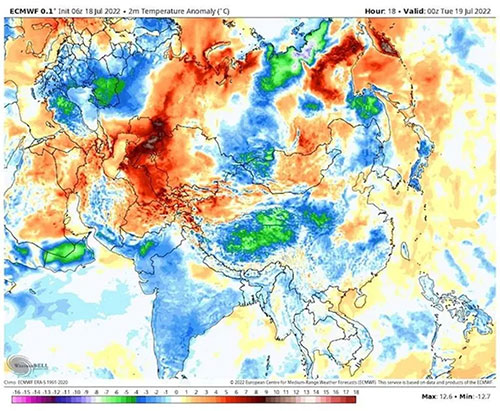
Temperature deviation from normal early on July 19 (UTC). (Photo: WeatherBell).
Wales recorded a record temperature on July 18, and the UK could see temperatures reach 40 degrees Celsius on July 19 (local time).
At the same time, the United States is also experiencing a heatwave, with temperatures in Salt Lake City hitting record levels on July 17. The heat in Texas and Oklahoma is expected to reach up to 45 degrees Celsius on July 19.
These heatwaves are believed to be part of the increasing frequency of extreme weather events caused by climate change.
Human activities are thought to be pushing temperatures, which have been elevated for many years, to record levels, according to the Washington Post.
Below are some weather maps illustrating the extreme heat in Europe and the US, as well as their historical context.
Temperatures over 20 degrees Celsius above normal in the UK
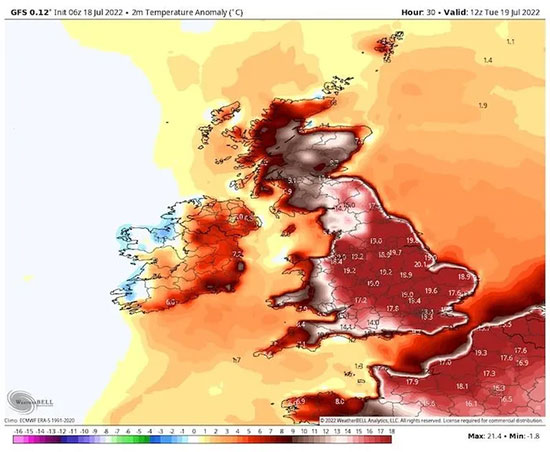
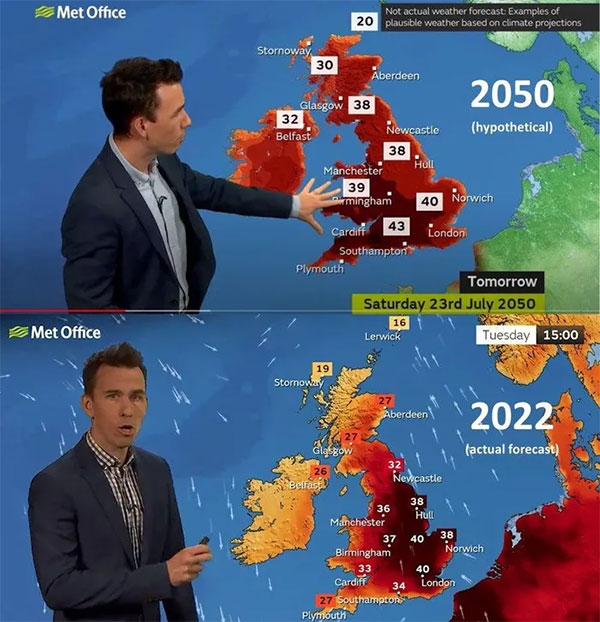
Photo: WeatherBell/UK Met Office.
Typical afternoon temperatures in mid-July in the UK hover around 20 degrees Celsius, but the country has recorded highs of 38 degrees Celsius, with expectations of further increases.
The maximum temperature predicted in the UK until the end of July 19 could reach 40 degrees Celsius, breaking the previous record of 38.7 degrees Celsius set in Cambridge on July 25, 2019.
In 2020, the UK Met Office projected that such temperatures would become common by 2050 due to climate change.
Nikos Christidis, a climate scientist at the UK Met Office, stated: “The likelihood of temperatures exceeding 40 degrees Celsius anywhere in the UK this year is rising rapidly. Even with current commitments to reduce emissions, such extreme events could occur once every 15 years in the 21st century.”
Unprecedented high average temperatures
The map below describes temperature anomalies based on European weather models from July 8 to July 16. The map indicates temperature variations at an altitude with a barometric pressure of 850 millibars, which is about 1 km above the ground.
Areas marked in dark red indicate “record high levels.” In other words, this weather model has never recorded temperatures this high during the same time of year.
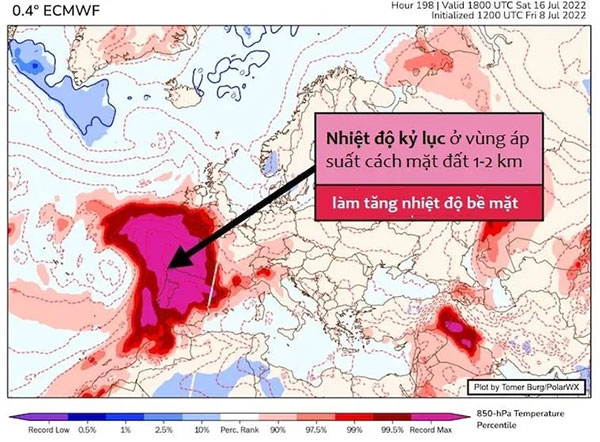
Graphic: PolarWX.com.
One of the most severe heatwaves in the UK occurred 46 years ago. Although it did not last as long as the 1976 heatwave, which featured 15 consecutive days with temperatures above 32 degrees Celsius, this year’s heat is forecasted to be more intense. The maximum temperature during the 1976 heatwave was 35.9 degrees Celsius, while this year’s figure is predicted to be 40 degrees Celsius.
This is not surprising considering the degree of warming since the 1970s. Average temperatures in the UK have risen by over 0.5 degrees Celsius since the mid-1970s, according to the Royal Society.
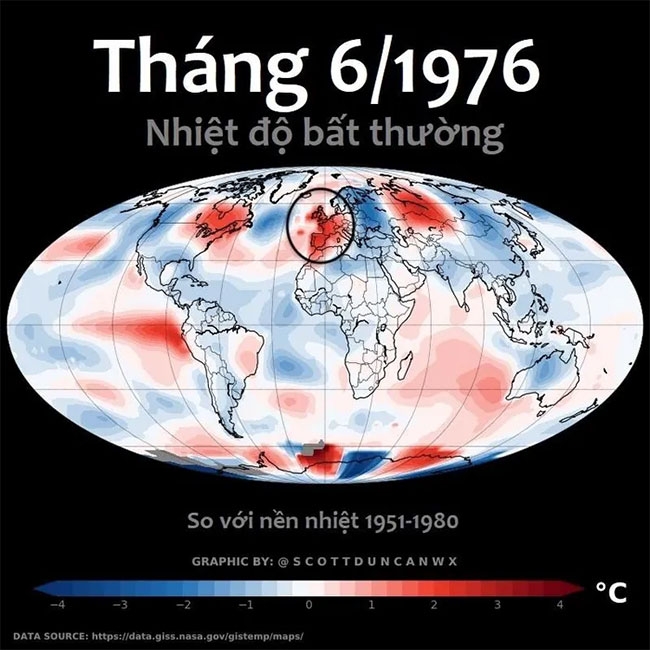
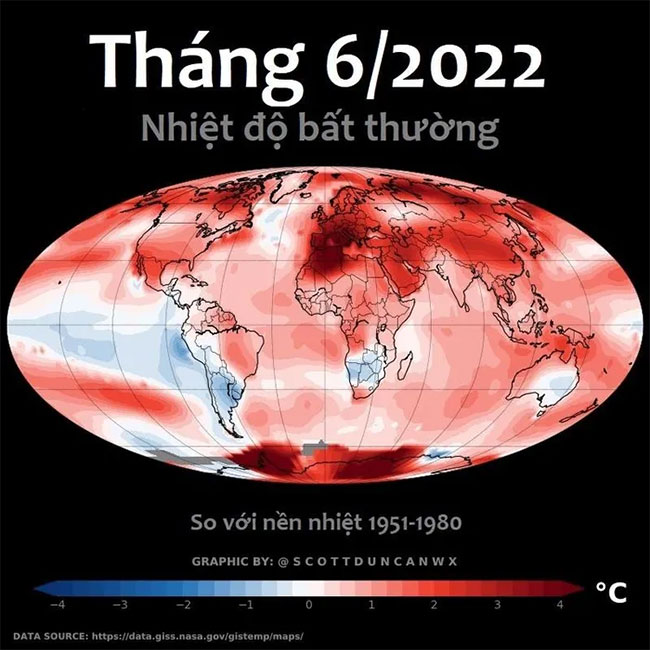
Photo: @ScottDuncanWX
The map from CoolWX.com below records real-time observations from weather stations in Western Europe and compares them with historical data. The observations were taken around 2 PM on July 18 (UK time). Each red dot marks a city that broke its daily temperature record. Purple dots represent a weather station currently reaching or breaking its monthly temperature record. Black circles with an “x” inside indicate areas that have reached or exceeded all-time high temperatures.
Some black circles can be seen in the southeastern regions of England.
On July 18, temperatures in Wales soared to 37.1 degrees Celsius, the highest ever recorded. The 33 degrees Celsius in Dublin marked the highest air temperature in Ireland in the 20th and 21st centuries.
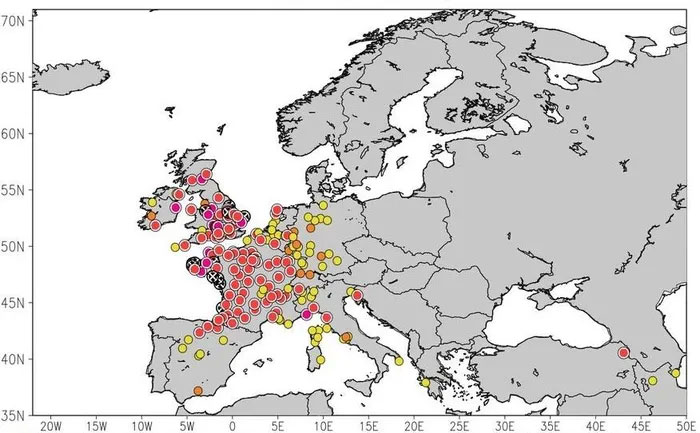 Photo: CoolWX.com.
Photo: CoolWX.com.
A series of records in the US
Temperatures of 38 degrees Celsius and above are rarely seen across the United States, from the southernmost regions bordering Mexico to the northern border with Canada.
However, the heat on July 18 exceeded this threshold. The southern plains are even forecasted to experience higher temperatures on July 19.
About 40 million people across 48 states are under heat advisories.
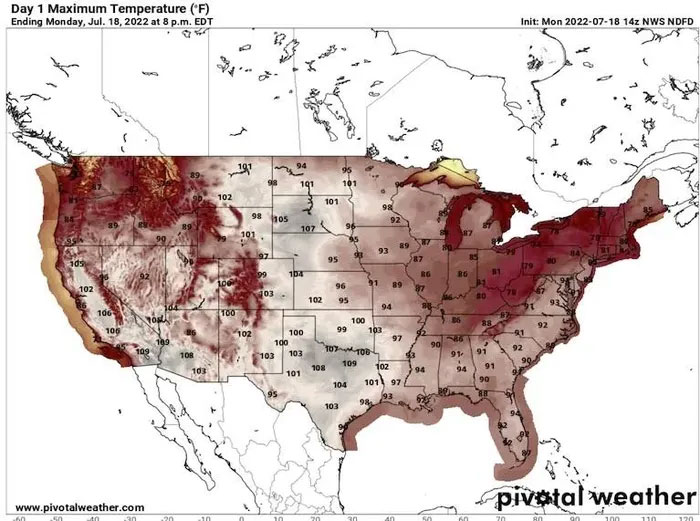
Temperatures are predicted to reach as high as 42.8 degrees Celsius in Dakota on July 18, and July 19 could see 44.4 degrees Celsius recorded in Wichita Falls, Texas. Temperatures above 38 degrees Celsius are expected to continue at least through the end of this week.
Numerous records have been set across the United States. On July 17, the heat in Salt Lake City climbed to 41.7 degrees Celsius, the highest temperature ever recorded in that city. Dodge City reached 42.8 degrees Celsius over the weekend of July 16-17, the highest temperature observed in any July. Even more northern regions, such as Glasgow, recorded temperatures of 42.2 degrees Celsius on July 18.


















































